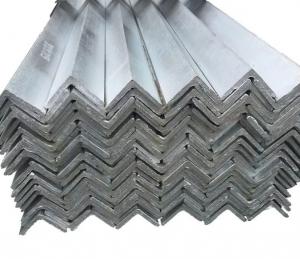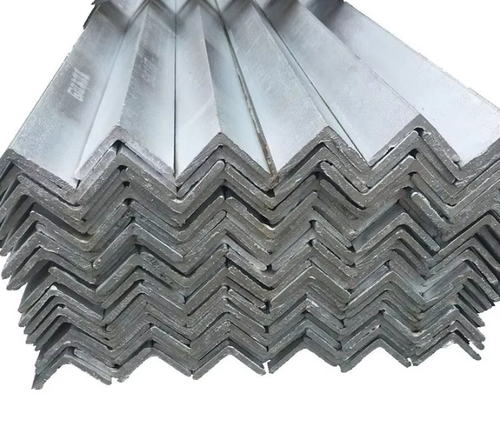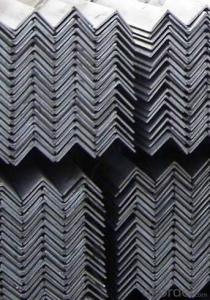ms equal angle bar angle steel angle iron black galvanized angle bar
- Loading Port:
- Tianjin
- Payment Terms:
- TT OR LC
- Min Order Qty:
- 25 m.t.
- Supply Capability:
- 200000 m.t./month
OKorder Service Pledge
OKorder Financial Service
You Might Also Like
Specification
We supply ms equal & unequal angle bar, channel bar,jis channel, upn, steel i beam,h beam, ipe, ipeaa, steel sheet pile, flat bar, hollow section, tmt bar, wire rod, binding wire, wire mesh, hrc, CRC, gi coil, ppgi, roofing sheet, chequered coil & plates, medium plate, scaffolding systems, prefabricated container houses etc. Also for metal & steel processing.
If you are in the market for any steel products, please feel free to contact us.
Steel Angle is one of the most popular hot rolled, low carbon steel shapes used in manufacturing, fabrication, and repair projects. From trailers to truck beds, farm implements to construction equipment, steel angle has thousands of uses and applications. Its 90 degree angle shape adds strength and rigidity to any project for a lower price compared to other shapes and types of metal. It is easy to weld, cut, form and machine. Rcjs steel stocks hundreds of sizes of steel angle that you can buy online in ready to ship precut or mill lengths or you can order just what you need custom Cut to Size in small or large quantity at wholesale prices.
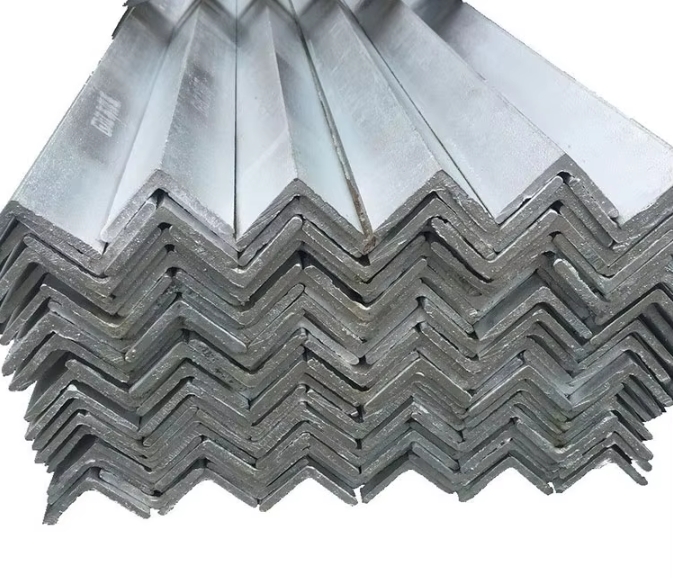
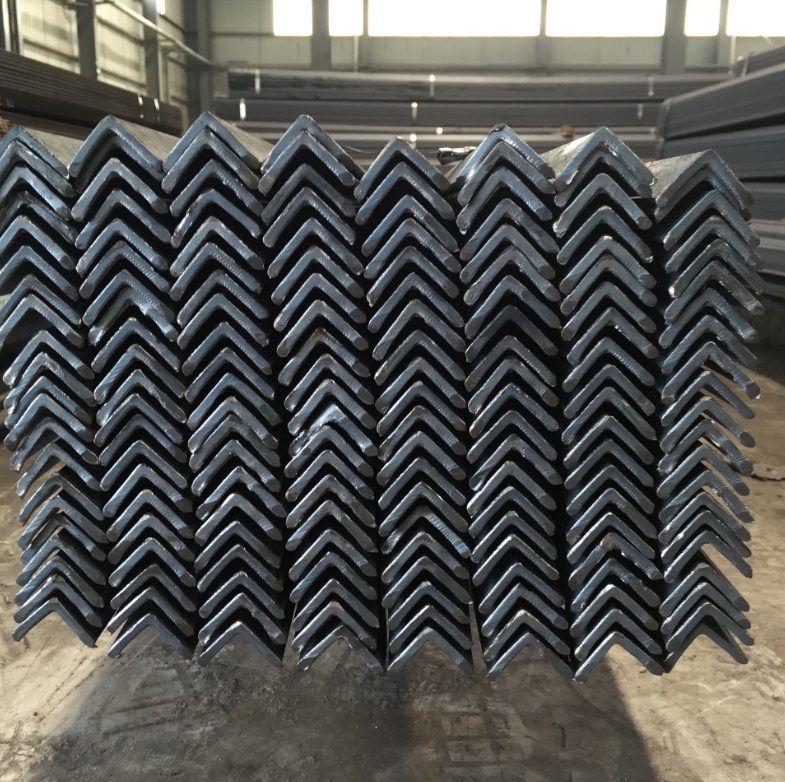
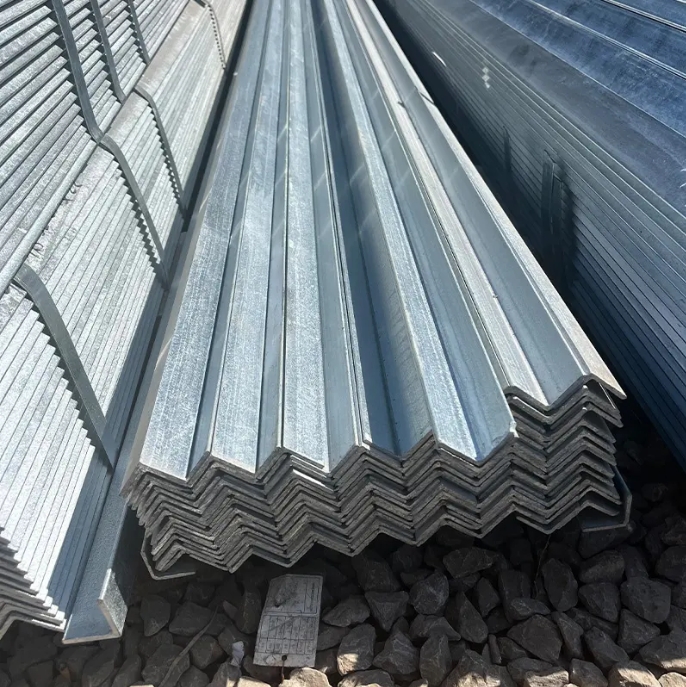
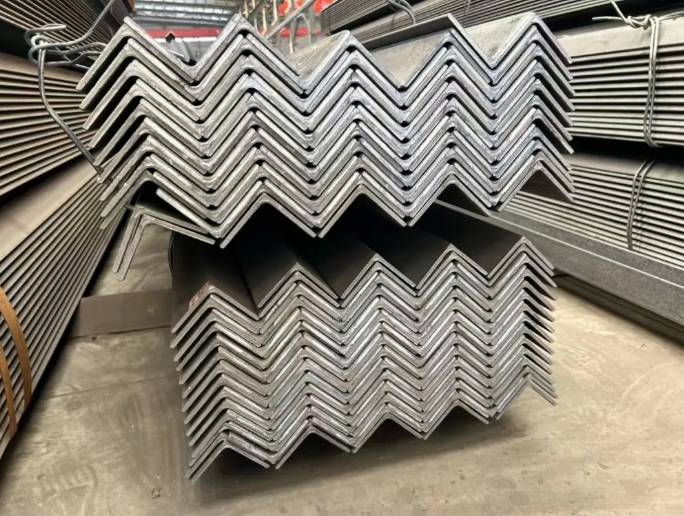
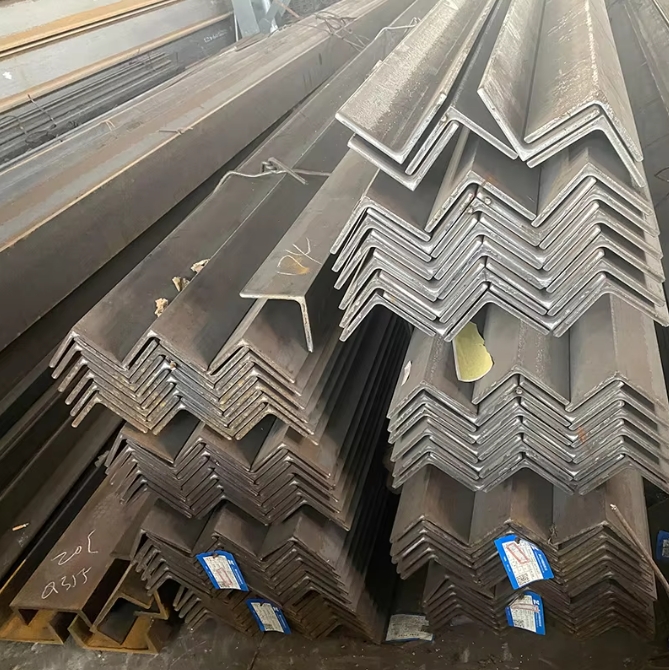

- Q: Can steel angles be used in solar panel mounting systems?
- Indeed, solar panel mounting systems can utilize steel angles. The selection of steel angles is commonly based on their robustness, longevity, and steadiness, which renders them suitable for sustaining the weight of solar panels. They can be conveniently manufactured and tailored to suit the precise prerequisites of a project. Additionally, steel angles furnish a secure foundation for solar panels, guaranteeing proper alignment and minimizing the potential harm caused by wind or other external elements. Nevertheless, it is crucial to account for the specific demands of the solar panel system and seek guidance from a structural engineer or a professional installer to ensure that the chosen steel angles fulfill the necessary load-bearing capacity and structural integrity standards.
- Q: Can steel angles be used in sign support structures?
- Yes, steel angles can be used in sign support structures. Steel angles are commonly used in construction as they provide excellent strength and structural support. They can be easily welded or bolted together to form sturdy sign support structures that can withstand various weather conditions and loads.
- Q: What are the different types of connections used for steel angles in industrial settings?
- In industrial settings, there are several types of connections used for steel angles depending on the specific application and structural requirements. Some of the commonly used connection types include: 1. Welded Connections: Welding is a popular method for connecting steel angles in industrial settings. It involves joining the angles using heat and pressure, resulting in a strong and durable connection. Welded connections are typically used when high strength and rigidity are required. 2. Bolting Connections: Bolts and nuts are used to connect steel angles in bolting connections. This type of connection allows for ease of assembly and disassembly, making it suitable for applications where flexibility and adjustability are important. Bolting connections can be easily tightened or loosened as needed. 3. Riveted Connections: Riveting involves using metal rivets to connect steel angles. This connection type offers good strength and stability and is commonly used in heavy-duty applications. Riveted connections require specialized equipment and skilled labor for installation and removal. 4. Adhesive Connections: Adhesives can also be used to bond steel angles together. This type of connection provides good load distribution and can be used in applications where welding or bolting is not feasible. Adhesive connections require proper surface preparation and adhesive selection to ensure adequate bonding strength. 5. Mechanical Connections: Mechanical connections such as cleats, brackets, plates, or clips can be used to connect steel angles. These connections provide flexibility and ease of installation, allowing for adjustments and modifications in the future if needed. It is important to note that the selection of the connection type depends on various factors such as the load-bearing capacity required, the structural design, safety considerations, and the specific environmental conditions in the industrial setting. Consulting with structural engineers and following industry standards and codes is crucial to ensure the appropriate type of connection is used for steel angles in industrial applications.
- Q: What are the different design considerations for steel angles in industrial buildings?
- There are several important design considerations for steel angles in industrial buildings. Firstly, the load-carrying capacity of the steel angles must be determined. This involves calculating the maximum possible loads that the angles will be subjected to, such as the weight of equipment, materials, and any potential dynamic loads. The angles must be designed to safely support these loads without excessive deflection or failure. Secondly, the structural stability of the steel angles must be ensured. This includes considering the buckling strength of the angles, especially if they are long and slender. Adequate bracing or connections may be necessary to prevent buckling under compressive loads. Thirdly, the connections of the steel angles to other structural elements must be carefully designed. The connections should be strong enough to transfer the loads between the angles and other components, such as beams or columns. The type of connection, such as bolted or welded, should be selected based on the specific requirements of the building and the expected loads. Additionally, considerations must be made for factors such as fire resistance and corrosion protection. Steel angles can be susceptible to fire damage, so fire-resistant coatings or fireproofing measures may be necessary to ensure the structural integrity of the building during a fire. Furthermore, appropriate corrosion protection measures, such as galvanization or coatings, should be applied to the steel angles to prevent rusting and deterioration over time. Finally, it is important to consider the aesthetic aspects of the steel angles in industrial buildings. While functionality and structural integrity are paramount, the design should also be visually appealing and fit within the overall architectural style of the building. This may involve selecting the appropriate size, shape, and finish of the steel angles to achieve the desired aesthetic effect. In summary, the design considerations for steel angles in industrial buildings include load-carrying capacity, structural stability, connections, fire resistance, corrosion protection, and aesthetics. By carefully addressing these factors, engineers can ensure the safe and efficient use of steel angles in industrial building design.
- Q: What are the limitations of using steel angles in corrosive or saltwater environments?
- The susceptibility of steel angles to corrosion limits their use in corrosive or saltwater environments. Since steel is mostly made up of iron, it can react with oxygen and water to form rust, or iron oxide. This corrosion process is accelerated in the presence of corrosive substances or saltwater. In these environments, there are a couple of limitations to consider. One limitation is the potential for accelerated corrosion. This can weaken the structural integrity of the steel angles, compromising the overall stability and safety of any structure they are used in. This is particularly concerning when the steel angles are load-bearing or subjected to significant stress. Another limitation is the shortened lifespan of steel angles in corrosive or saltwater environments. The ongoing corrosion process significantly reduces their lifespan, leading to more frequent maintenance or replacement needs. This can result in higher costs and potential disruptions to operations or projects. Additionally, the appearance of steel angles can be negatively affected by corrosion in corrosive or saltwater environments. The surface of the steel can develop rust stains, which are aesthetically unappealing, especially when the steel angles are visible. To overcome these limitations, alternative materials can be considered for corrosive or saltwater environments. For example, stainless steel contains a high proportion of chromium, which gives it enhanced corrosion resistance. Additionally, protective coatings or treatments like galvanizing or epoxy coatings can be applied to steel angles to create an extra barrier against corrosion. In conclusion, although steel angles are versatile and commonly used in various applications, their use in corrosive or saltwater environments is limited due to their susceptibility to corrosion. It is important to carefully assess the specific environment and explore alternative materials or protective measures to ensure the longevity and integrity of any structure or project.
- Q: What are the different methods of connecting steel angles to other structural elements?
- There are several methods of connecting steel angles to other structural elements, depending on the specific application and load requirements. One common method is through welding. Welding involves melting and fusing the steel angle to the other structural element using intense heat. This creates a strong and durable connection that can withstand high loads. Welding is often used when the connection needs to be permanent and when the load requirements are significant. Another method is through bolting. Bolting involves using bolts and nuts to secure the steel angle to the other structural element. This method allows for easy disassembly and reassembly if needed, making it more flexible than welding. Bolting is often used when the connection needs to be adjustable or when the load requirements are relatively lower. Riveting is another method that can be used to connect steel angles to other structural elements. Riveting involves joining the steel angle and the other element by inserting a metal pin, called a rivet, through aligned holes and then deforming the end of the rivet to secure it in place. This method creates a strong and reliable connection, but it may be more time-consuming and labor-intensive compared to welding or bolting. Additionally, adhesive bonding can also be used to connect steel angles to other structural elements. This method involves using specialized adhesives that can bond the surfaces of the steel angle and the other element together. Adhesive bonding can provide a strong and uniform connection, and it is often used when aesthetics are important or when joining dissimilar materials. In summary, the different methods of connecting steel angles to other structural elements include welding, bolting, riveting, and adhesive bonding. The choice of method depends on factors such as the load requirements, desired flexibility, ease of assembly and disassembly, and the specific application.
- Q: What are the different types of steel angles used in manufacturing?
- There are several types of steel angles commonly used in manufacturing, including equal angles, unequal angles, L-shaped angles, and T-shaped angles. These angles are used in various industries and applications, such as construction, engineering, and manufacturing of machinery and equipment.
- Q: What are the design considerations for using steel angles in architectural applications?
- Some design considerations for using steel angles in architectural applications include structural stability, load-bearing capacity, aesthetic appeal, corrosion resistance, and ease of installation. Steel angles are commonly used to provide support, reinforcement, and stability to various architectural elements such as beams, columns, and frames. The selection of the appropriate size, thickness, and grade of steel angle is crucial to ensure the structural integrity and safety of the building. Additionally, architects may consider the visual impact of steel angles, as they can be exposed or concealed depending on the design intent. The corrosion resistance properties of the steel angles should also be taken into account, especially in applications where exposure to moisture or harsh environments is expected. Lastly, the ease of installation and compatibility with other building materials should be considered to streamline the construction process.
- Q: Are steel angles corrosion resistant?
- Steel angles are generally not corrosion resistant unless they are specifically designed and treated to be so. Regular steel angles are made from carbon steel, which is susceptible to corrosion when exposed to moisture, oxygen, and other corrosive elements. However, there are stainless steel angles available that have a higher resistance to corrosion due to the addition of chromium and other alloying elements. These stainless steel angles are commonly used in environments where corrosion is a concern, such as marine or industrial applications. It is important to consider the specific type and grade of steel angle being used to determine its corrosion resistance capabilities.
- Q: What are the different types of steel angles used in automotive engineering?
- In automotive engineering, there are several types of steel angles that are commonly used. These angles play a crucial role in providing structural strength, improving stability, and enhancing the overall performance and safety of vehicles. Here are some of the different types of steel angles used in automotive engineering: 1. L-angles: L-angles, also known as unequal angles, are often used in automotive engineering to provide structural support and reinforcement. These angles have different lengths on each side, allowing them to be easily welded or bolted onto various components of a vehicle's chassis or frame. 2. T-angles: T-angles, also known as tee angles, are frequently used in automotive engineering to join two components together at a right angle. These angles are designed with a flat base and a vertical stem, which enables them to provide stability and hold different parts of a vehicle securely in place. 3. C-angles: C-angles, also known as channel angles, are commonly utilized in automotive engineering to form the framework for various vehicle structures. These angles have a U-shaped cross-section and are often used to create structural components like door frames, roof rails, and chassis reinforcements. 4. Z-angles: Z-angles, also known as Z-bar angles, are widely employed in automotive engineering to provide strength and rigidity to different vehicle structures. These angles have a Z-shaped cross-section, which allows them to resist bending and torsional forces effectively. Z-angles are often used in applications such as suspension systems, roll bars, and body components. 5. U-angles: U-angles, also known as U-bar angles, are commonly used in automotive engineering to provide support and reinforcement to various vehicle components. These angles have a U-shaped cross-section and are frequently utilized to create structural members like bumper beams, frame reinforcements, and roll cage bars. These are just a few examples of the different types of steel angles used in automotive engineering. Each angle has its own unique properties and applications, and their selection depends on the specific requirements of the vehicle design and the desired structural integrity.
Send your message to us
ms equal angle bar angle steel angle iron black galvanized angle bar
- Loading Port:
- Tianjin
- Payment Terms:
- TT OR LC
- Min Order Qty:
- 25 m.t.
- Supply Capability:
- 200000 m.t./month
OKorder Service Pledge
OKorder Financial Service
Similar products
Hot products
